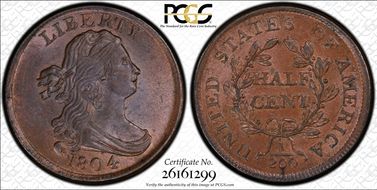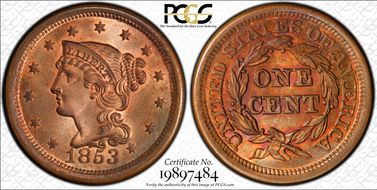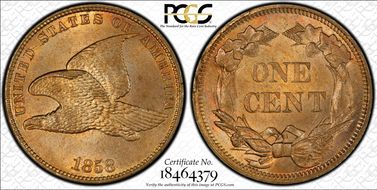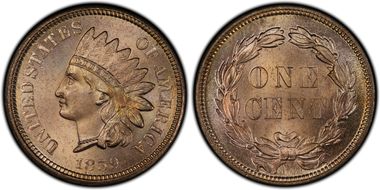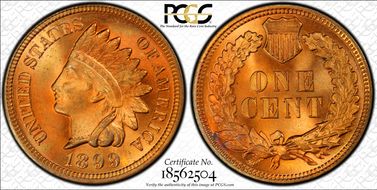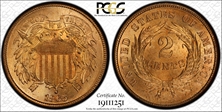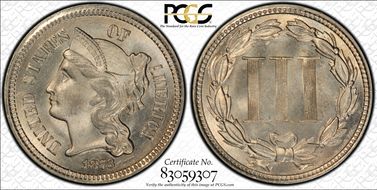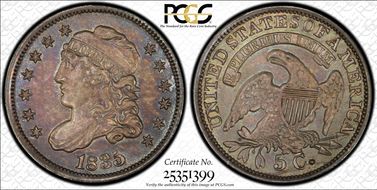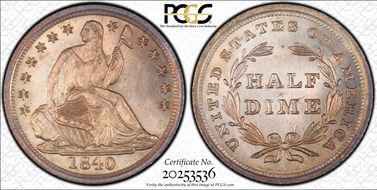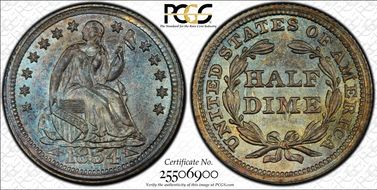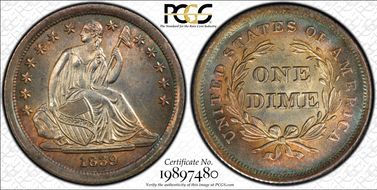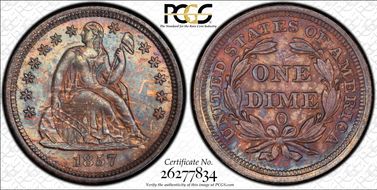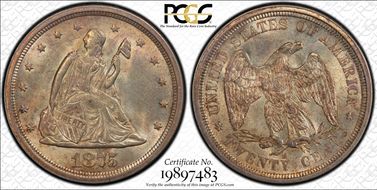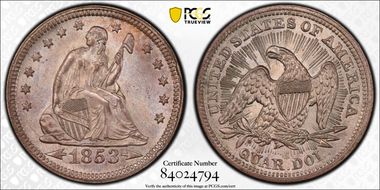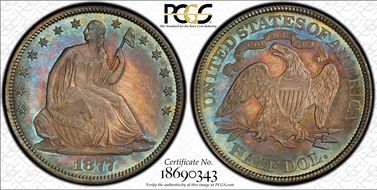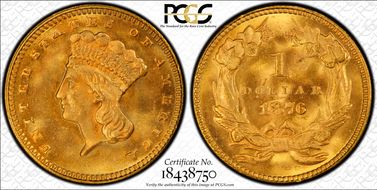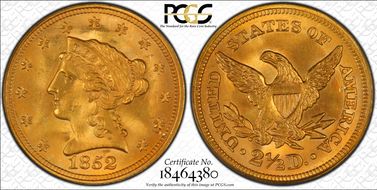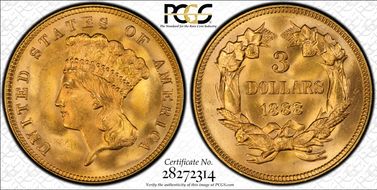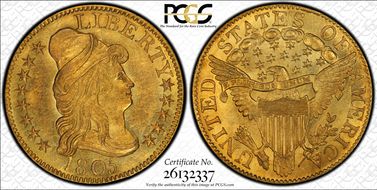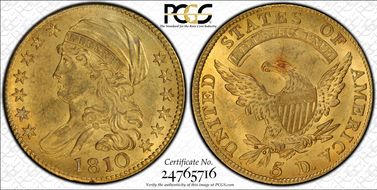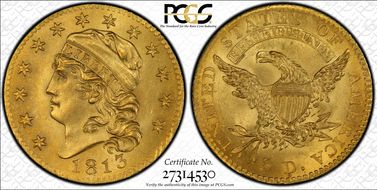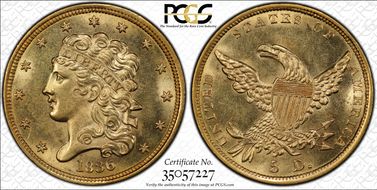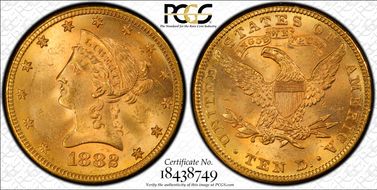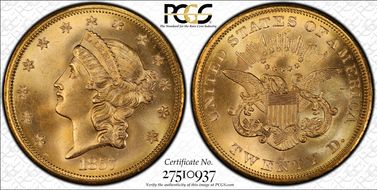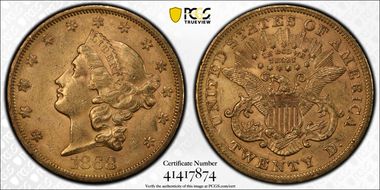Jesh 的钱币相册
CAC. A decent luster enlivens the original rich brown colors on this near gem. Details on Miss Liberty are exceptionally struck. POP 27/3. CAC 7. (9/12)
CAC. A decent light glossy luster shows off beautiful even chocolate brown color.
CAC. A decent light glossy luster shows off beautiful even chocolate brown color.
CAC. O-131, R.2. The obverse with die line above the LI of LIBERTY, the reverse with "Leaning 0" in the denomination. This is a gorgeous near-Gem that is ideal for the type collector seeking a high-end Bust half. The strike is solid, if a trifle incomplete on the highest design elements, and the luster is warm silver overall with gold and violet elements at the borders. Purchased as MS65 - Non CAC.
CAC. O-131, R.2. The obverse with die line above the LI of LIBERTY, the reverse with "Leaning 0" in the denomination. This is a gorgeous near-Gem that is ideal for the type collector seeking a high-end Bust half. The strike is solid, if a trifle incomplete on the highest design elements, and the luster is warm silver overall with gold and violet elements at the borders. Purchased as MS65 - Non CAC.
CAC. You do not have to tilt this coin to see all its beautiful colors. Warm shades of violet/golden brown/amber blaze from both sides (on the image the coin may appear slightly speckled-it is not). Overall, the surfaces are extremely clean and radiate with an intense luster. Every detail is sharply struck and appears boldly. No matter how picky you are, this coins quality and color WILL impress you! Not an easy date to find in true problem free GEM. PCGS 51, NGC 71. PCGS has graded only 8 coins higher.
CAC. You do not have to tilt this coin to see all its beautiful colors. Warm shades of violet/golden brown/amber blaze from both sides (on the image the coin may appear slightly speckled-it is not). Overall, the surfaces are extremely clean and radiate with an intense luster. Every detail is sharply struck and appears boldly. No matter how picky you are, this coins quality and color WILL impress you! Not an easy date to find in true problem free GEM. PCGS 51, NGC 71. PCGS has graded only 8 coins higher.
CAC. A strong luster shows off the surfaces and a gorgeous crescent of reddish gold/gold/green/navy colors-mostly on the obverse. All of the details are sharply struck. The eye appeal is fantastic!
CAC. A strong luster shows off the surfaces and a gorgeous crescent of reddish gold/gold/green/navy colors-mostly on the obverse. All of the details are sharply struck. The eye appeal is fantastic!
CAC. The generous mintage of three cent silvers in 1856 was more than 1.45 million coins. The Gem level is the finest usually encountered, however. This MS65 Type Two specimen offers lovely hues of pink, gold, and lilac with excellent luster and eye appeal. Population: 21 in 65, 3 finer (7/10)
CAC. The generous mintage of three cent silvers in 1856 was more than 1.45 million coins. The Gem level is the finest usually encountered, however. This MS65 Type Two specimen offers lovely hues of pink, gold, and lilac with excellent luster and eye appeal. Population: 21 in 65, 3 finer (7/10)
CAC. This Civil War Premium Gem has mildly prooflike fields and only a hint of tan toning. No marks are visible, and the strike is decidedly above average. PCGS has certified just 11 pieces finer (10/09).
CAC. This Civil War Premium Gem has mildly prooflike fields and only a hint of tan toning. No marks are visible, and the strike is decidedly above average. PCGS has certified just 11 pieces finer (10/09).
CAC. EX: Newman/Green. A moderate luster shows off rich original navy, purple, and gold colors that spread all over. A need sharp strike with full details.
Pink, peach, and gold overtones are most prominent at the margins. An immensely lustrous Gem example from early in the Seated half dime series. Population: 17 in 65, 18 finer (12/10).
Pink, peach, and gold overtones are most prominent at the margins. An immensely lustrous Gem example from early in the Seated half dime series. Population: 17 in 65, 18 finer (12/10).
CAC. Some light die clashing (mint made) are on both sides. A booming luster shows the original colors of blue, gold, and green that swirl all over this awesome coin with an exceptional strike.
CAC. JR-5, R.1. The 4 in the date shows the crossbar partially broken off, with a sharp pointed fragment still visible. On the reverse, the last A in AMERICA is joined to the C and to the arrowhead. The lustrous surfaces of this near-Gem display splashes of forest-green and lavender, more extensive and deeper on the obverse. This sharply struck piece has been well cared for. Population: 18 in 64, 11 finer (11/11).
CAC. JR-5, R.1. The 4 in the date shows the crossbar partially broken off, with a sharp pointed fragment still visible. On the reverse, the last A in AMERICA is joined to the C and to the arrowhead. The lustrous surfaces of this near-Gem display splashes of forest-green and lavender, more extensive and deeper on the obverse. This sharply struck piece has been well cared for. Population: 18 in 64, 11 finer (11/11).
CAC.The austere elegance of Christian Gobrecht's No Stars dime design--Liberty seated against a plain background on the obverse with date below, the reverse with UNITED STATES OF AMERICA around a simple wreath with ONE / DIME inside--makes it one of the simplest but also one of the most classically beautiful 19th century coinage designs. This lustrous, softly frosted Gem offers great eye appeal thanks to broad strokes of blue, violet, green, gold, and orange patina that leave only a few windows of original silver. Population: 25 in 65, 7 finer (11/10)
CAC.The austere elegance of Christian Gobrecht's No Stars dime design--Liberty seated against a plain background on the obverse with date below, the reverse with UNITED STATES OF AMERICA around a simple wreath with ONE / DIME inside--makes it one of the simplest but also one of the most classically beautiful 19th century coinage designs. This lustrous, softly frosted Gem offers great eye appeal thanks to broad strokes of blue, violet, green, gold, and orange patina that leave only a few windows of original silver. Population: 25 in 65, 7 finer (11/10)
CAC. EX: Simpson. PCGS Secure. Fortin-101. The 39 are repunched with recutting on stars 5 and 6, The reverse has a short die crack below the R in AMERICA. This beautiful and bold Gem has frosty silver surfaces with delicate peripheral gold and blue toning on each side. Population: 13 in 65, 19 finer (8/10).
CAC. EX: Simpson. PCGS Secure. Fortin-101. The 39 are repunched with recutting on stars 5 and 6, The reverse has a short die crack below the R in AMERICA. This beautiful and bold Gem has frosty silver surfaces with delicate peripheral gold and blue toning on each side. Population: 13 in 65, 19 finer (8/10).
CAC. EX: Simpson. PCGS Secure. Fortin-101. The 39 are repunched with recutting on stars 5 and 6, The reverse has a short die crack below the R in AMERICA. This beautiful and bold Gem has frosty silver surfaces with delicate peripheral gold and blue toning on each side. Population: 13 in 65, 19 finer (8/10).
CAC. Large O. This sharply detailed gem offers vibrant mint luster with an attractive blue and gold patina. The eye appeal is outstanding. 12/10 (5/12) 13/10 (1/14)
CAC. Ex: Eliasberg. The obverse die is worn and the reverse die is crisp with evidence of a repunched mintmark. This splendid Premium Gem has attractive medium gold toning over frosty luster. Population: 7 in 66, 2 finer (8/10). Ex: Chapman Brothers (5/1900); J.M. Clapp; Clapp Estate; Louis E. Eliasberg, Sr.; Eliasberg Estate (Bowers and Merena, 5/1996), lot 1239.
CAC. Ex: Eliasberg. The obverse die is worn and the reverse die is crisp with evidence of a repunched mintmark. This splendid Premium Gem has attractive medium gold toning over frosty luster. Population: 7 in 66, 2 finer (8/10). Ex: Chapman Brothers (5/1900); J.M. Clapp; Clapp Estate; Louis E. Eliasberg, Sr.; Eliasberg Estate (Bowers and Merena, 5/1996), lot 1239.
CAC. Ex: Eliasberg. The obverse die is worn and the reverse die is crisp with evidence of a repunched mintmark. This splendid Premium Gem has attractive medium gold toning over frosty luster. Population: 7 in 66, 2 finer (8/10). Ex: Chapman Brothers (5/1900); J.M. Clapp; Clapp Estate; Louis E. Eliasberg, Sr.; Eliasberg Estate (Bowers and Merena, 5/1996), lot 1239.
(CAC) O-131, R.2. The obverse with die line above the LI of LIBERTY, the reverse with "Leaning 0" in the denomination. This is a gorgeous near-Gem that is ideal for the type collector seeking a high-end Bust half. The strike is solid, if a trifle incomplete on the highest design elements, and the luster is warm silver overall with gold and violet elements at the borders. Purchased as MS64.
(CAC) O-131, R.2. The obverse with die line above the LI of LIBERTY, the reverse with "Leaning 0" in the denomination. This is a gorgeous near-Gem that is ideal for the type collector seeking a high-end Bust half. The strike is solid, if a trifle incomplete on the highest design elements, and the luster is warm silver overall with gold and violet elements at the borders. Purchased as MS64.
CAC. The luster highlights the killer ring of sea royal blue which opens into violet and fiery tangerine centers. Splashes of prooflike mirrors are vivid all over. Under the colors are a few OLD light marks, but nothing that's visible or detracting from the grade. Miss Liberty and the details are frosty and have full strikes.(Upgraded from MS65)
CAC. The luster highlights the killer ring of sea royal blue which opens into violet and fiery tangerine centers. Splashes of prooflike mirrors are vivid all over. Under the colors are a few OLD light marks, but nothing that's visible or detracting from the grade. Miss Liberty and the details are frosty and have full strikes.(Upgraded from MS65)
CAC. Orange-red and olive-green toning is beautiful, and the obverse appears immaculate.
CAC. Orange-red and olive-green toning is beautiful, and the obverse appears immaculate.
CAC. An intense luster shows off a subtle mix of brilliant yellow gold/orange gold colors.
CAC. An intense luster shows off a subtle mix of brilliant yellow gold/orange gold colors.
CAC. Breen-6444, BD-3, High R.5. A moderate mintage of 33,183 Capped Bust Right half eagles was achieved in 1805, with five different die marriages known to collectors today. The coin offered here is an example of the rare BD-3 variety, characterized by the imperfect 1 in the date, star 1 distant from the bust, and star 9 close to Y in LIBERTY. John Dannreuther estimates an initial mintage of 2,000-3,000 pieces for BD-3, with a surviving population of 35-45 examples. The present coin is an attractive example, with noticeably prooflike fields. Heavy clash marks can be seen in the right reverse field, with some adjustment marks in the center obverse. Sharply struck, with exquisite detail on the central devices, and only slight weakness on the peripheral stars. A few scattered field marks prevent an even higher grade. Population (all varieties): 44 in 62, 58 finer (11/11).
CAC. Breen-6444, BD-3, High R.5. A moderate mintage of 33,183 Capped Bust Right half eagles was achieved in 1805, with five different die marriages known to collectors today. The coin offered here is an example of the rare BD-3 variety, characterized by the imperfect 1 in the date, star 1 distant from the bust, and star 9 close to Y in LIBERTY. John Dannreuther estimates an initial mintage of 2,000-3,000 pieces for BD-3, with a surviving population of 35-45 examples. The present coin is an attractive example, with noticeably prooflike fields. Heavy clash marks can be seen in the right reverse field, with some adjustment marks in the center obverse. Sharply struck, with exquisite detail on the central devices, and only slight weakness on the peripheral stars. A few scattered field marks prevent an even higher grade. Population (all varieties): 44 in 62, 58 finer (11/11).
CAC. Purchased as MS63/CAC. State c/b. Die clashing is seen most notably at the top of the obverse above the cap. This common early gold type coin has an estimated survival of 500 to 750 pieces, out of an a total of 75,000 to 90,000 originally minted. Of course, the vast majority of those produced were melted from the date of issue through 1834, at which time gold coins became worth less than their intrinsic value. This is a lovely orange-gold example whose color is only interrupted by a spot of copper (from improper mixture of the gold/copper alloy in that area) over the eagle's eye. The devices are sharply struck throughout, and there are no obvious or detracting abrasions. (Upgrade from MS63) EX: Oliver Collection PCGS 1/35 (05/15)
CAC. Purchased as MS63/CAC. State c/b. Die clashing is seen most notably at the top of the obverse above the cap. This common early gold type coin has an estimated survival of 500 to 750 pieces, out of an a total of 75,000 to 90,000 originally minted. Of course, the vast majority of those produced were melted from the date of issue through 1834, at which time gold coins became worth less than their intrinsic value. This is a lovely orange-gold example whose color is only interrupted by a spot of copper (from improper mixture of the gold/copper alloy in that area) over the eagle's eye. The devices are sharply struck throughout, and there are no obvious or detracting abrasions. (Upgrade from MS63) EX: Oliver Collection PCGS 1/35 (05/15)
CAC. BD-1, R.2. Bass-Dannreuther Die State b/b. The Capped Bust Left design was modified in 1813, with the bust and eagle restyled and the stars arranged in a continuous arc above the portrait, instead of the 7x6 arrangement of the previous design. A substantial mintage of 95,428 pieces was achieved, with only two die varieties known for the date. This coin represents the more available BD-1 variety, identified by the position of the first S in STATES over the right side of E in PLURIBUS. The BD-1 is the only readily available date and variety of this design type, making it a favorite choice of type collectors. The BD-1 probably accounted for 60,000-75,000 pieces of the reported mintage, with a surviving population of 450-650 examples in all grades. John Reich's secret signature star punch, with the notched outside point, was used on star 13. The obverse die was also used to strike the BD-2 variety of this date, but the BD-1 is the only use of the reverse die. As a date, 1813 half eagles have been avidly collected since the 1850s, with an example appearing in lot 187 of the A.C. Kline Sale (Moses Thomas & Sons, 6/1855). More recent sales include the appearance of the present coin in lot 5093 of the FUN Signature (Heritage, 1/2011), which realized $48,875. The coin offered here is a spectacular near-Gem example, with pleasing yellow-gold surfaces and strong rose highlights at the peripheries. The design elements are sharply detailed, and vibrant mint luster beams on both sides. A few light adjustment marks appear on Liberty's cheek on close inspection, but they have little impact on the coin's extraordinary visual appeal. Population: 48 in 64, 3 finer (6/12). 48/4 (1/14)
CAC. Philadelphia Mint gold eagle production reached new heights in the early 1880s. In 1882 the total mintage was more than 2.3 million coins. However, Choice or Gem Mint State examples are conditionally rare. This piece has brilliant and highly lustrous orange-gold surfaces with full mint frost. Population: 31 in 64, 1 finer (10/09).
CAC. Philadelphia Mint gold eagle production reached new heights in the early 1880s. In 1882 the total mintage was more than 2.3 million coins. However, Choice or Gem Mint State examples are conditionally rare. This piece has brilliant and highly lustrous orange-gold surfaces with full mint frost. Population: 31 in 64, 1 finer (10/09).
CAC. Spiked Shield, Variety 20A. Ex: S.S. Central America. SSCA 2796. The Central America went from being an almost-forgotten maritime disaster to an oft-told treasure tale after the discovery of the wreck -- and the golden cargo within. This Premium Gem 1857-S double eagle was one of thousands packed tightly together on the ship and bound for New York with who-knows-what eventual fate when a hurricane sank the Central America. After more than a century and a quarter, this coin and its fellows changed collector understanding of the 1857-S double eagle forever. Despite being packed for shipping, riding through two rough oceans, sinking in a hurricane, and being raised from the ocean floor, this Premium Gem has come through hardly the worse for events (and obviously with no wear). Canary-gold luster, bright and pale, deepens slightly toward the rims. A tiny mark along Liberty's chin is well within the bounds of the grade. Offered alone (no box or paperwork), but this coin and its gold-insert holder carry their own credentials. From The Richard P. Ariagno, M.D. Collection




















